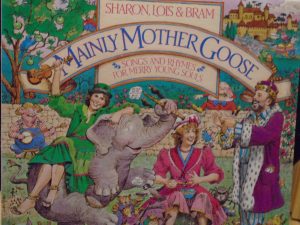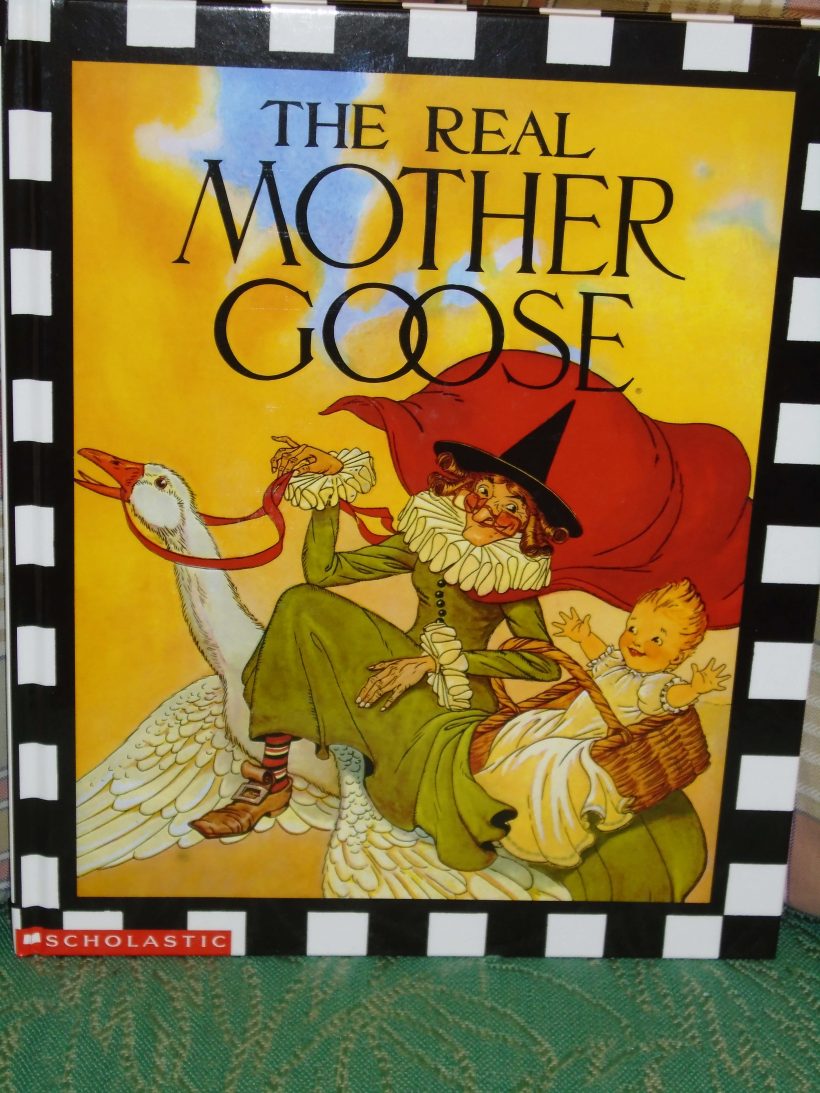Mother Goose by BARNEY MOORHOUSE For Reproduction Rights Call Access 1.800.893.5777
OLD MOTHER GOOSE BY I.W.T.
Pussy Cat, Pussy Cat, where have you been?
I’ve been to London to see the Queen.
Pussy Cat, Pussy Cat, what did you do there?
I chased a wee mouse under a chair.
Childish, no doubt, but delightful and displaying a real sense of humour.
There was a time when almost every child was familiar with the poems of Mother Goose. Then a group of educators, so called, decided that such poems were unsuitable for children. They inspired wrong ideas in young minds and some of them were definitely harmful, so they said. Others tried to improve on the originals by altering certain parts which they considered unsuitable for the eyes and ears of children but without exception the selection was ruined. These reformers belonged to the same group as those authorities on childhood education who tried to improve such stories as ‘Little Red Riding hood’ and ‘The Three Little Pigs’ by deleting the tragedies which are the main points in the stories and substituting wishy-washy incidents that even the most simple-minded child must listen to with disdain. In my opinion no child was ever harmed by hearing of the fate of the grandmother. If it did trouble her for a moment, all thought of it was forgotten in hearing about the thrilling escape of the child and the well-deserved fate of the wolf.
The same is true of the fates of the first two little pigs, fates which the child recognizes as the just deserts of carelessness and laziness. As for the incidents that were introduced as substitutes for the original thrills, nothing could be less convincing and more feeble.
The poems of Mother Goose are in a class by themselves. There have been imitators but no equals. They are sometimes called Nursery Rhymes but they are more than that. Of course they were not composed by Mother Goose. She was just the person who gathered together all these verses that had been handed down from parents to children for hundreds of years and put them in one volume. Many of them have come down practically unchanged through several centuries and others much longer. Some of them can be accurately dated from incidents and manners described. Such as ‘London Bridge is falling down’ which refers to a definite historical incident. ‘Taffy was a Welshman’ and ‘Simple Simon’ and many others belong definitely within certain periods of English history.
During recent years, Mother Goose has been regaining popularity. It seems incredible that there are people who have never heard of Mother Goose and know nothing of her poetry. I still think any child who has missed an early acquaintance with Mother Goose along with Hans Anderson and Grimm’s Fairy Tales has been deprived of the most enjoyable features of childhood. The selections in the primary school readers contain nothing worthy of comparison. Let us have more of Mother Goose.
The above item was written by I.W.T. (I Was There) in 1964 when he was approximately 69 years of age. A WW1 vet and schoolteacher, I.W.T. grew up in Bancroft. I was friends with his niece, centenarian Marguerite McColl, also a school teacher and a source for I.W.T.’s writings.

ABOUT MOTHER GOOSE
When I.W.T. wrote about Mother Goose and bemoaned the educators’ lack of respect I was inspired to do some research. Bear in mind I am not working on a PhD dissertation. I was just looking for some basic information. And so I deviate somewhat from my usual format.
Chronologically speaking, French poet Jean Loret first mentioned Mother Goose in his book La Muze Historique published in 1650, 374 years ago.
Charles Perrault was the first to publish a Mother Goose collection of rhymes and other folk tales in 1695 in Paris, France (in case you were wondering.) “Essentially he initiated the fairy tale genre.” Mother Goose personifies an imaginary author that collected, perhaps akin to an anthology, a collection of French fairy tales, and later English nursery rhymes that were translated into English as Tales of My Mother Goose.
In 1729 Perrault’s collection Les Contes de ma Mere l’Oye also included Robert Samber’s English translation Histories or Tales of Past Times, Told by Mother Goose which introduced Sleeping Beauty, Little Red Riding Hood, Puss in Boots and Cinderella among others to English-speaking audiences.
At a later date a compilation of English nursery rhymes entitled Mother Goose’s Melody or Sonnets for the Cradle published during the 1760s by John Newbery and later in 1780 or 1781 by Thomas Carnan, Newbery’s stepson, helped perpetuate the name in Britain and the United States.
In 1786 Isaiah Thomas reprinted Samber’s work under the same title thus introducing Mother Goose to Worcester, Massachusetts.
During the 20th century Katherine Elwes-Thomas suggested that the image and name “Mother Goose” might be based upon ancient legends of the wife of King Robert 11 of France who was known as “Bertha the Spinner” (for the tales she spinned that captured the child’s imagination) or “Goose-Footed Bertha”. Other scholars have pointed out that one can trace Mother Goose to the Queen of Sheba.
“Despite evidence to the contrary,” some Americans have claimed that the original Mother Goose was from Boston, married to Isaac Goose and was known as Mary Goose (1665-1758). Apparently Mary was Isaac’s second wife bringing her 6 children to join with his 10 for what might be considered a magnificent blended family. Apparently Mary “Mother Goose” used to sing songs for her grands and other children were also attracted. Word has it that her son-in-law gathered her ditties and printed them but no such evidence exists to prove this.
Bottom line – Mother Goose was not a particular person.
When Charles Perrault gathered his collection of fairy tales and stories from past times complete with morals they became popular as fairy tales were at that time fashionable among the aristocrats.
Apparently only one poem was written about Mother Goose who was often illustrated as an old woman wearing a shawl complete with a tall hat riding upon a goose; or as a goose bedecked in a bonnet and reading glasses.
Old Mother Goose,
When she wanted to wander,
Would ride through the air
On a very fine gander.
Jack’s mother came in,
And caught the goose soon,
And mounting its back,
Flew up to the moon.
There are apparently approximately 700 items in the Mother Goose collection and many of the lyrical rhymes are sung helping children to develop their language skills. Baa Baa Black Sheep, Twinkle Twinkle Little Star and Three Blind Mice are just a few examples. Perhaps readers may have sung Jack and Jill Went Up the Hill, or recited This Little Piggy Went to Market on their children’s or grand’s toes to the child’s great delight? Peter Piper picked a peck of pickled peppers would be more challenging to sing, let alone recite.
Perhaps readers have copies of Mother Goose in their home libraries or on vinyl records? I didn’t appreciate how many of these we homed until the grands came upon the scene.
CANUCKIANA
“When Mother Goose hit Dracula with a feather duster it was down for the Count.” Anon.
Photos – by B.M.
